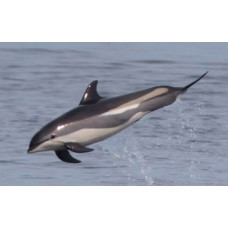Latin name
Lagenorhynchus acutus
Identification
The Atlantic white-sided dolphin is characterized by its shortened head and beak. Its genus name, Lagenorhynchus, is derived from the Greek words lagénos, meaning "bottle" or "flask," and rhúnkhē, meaning "beak" or "snout."
Features of fish fins
The dorsal fin of dolphins of this species is slightly forward of center.
Fish colouring
This dolphin's main distinguishing feature is a large white or yellow spot that begins on either side of the dorsal fin and extends along its entire body. These animals' undersides, including their heads, throats, and bellies, are white, while their fins and backs are black.
Distribution
It inhabits the cold and temperate latitudes of the North Atlantic Ocean. It is found off the coasts of Newfoundland and Cape Cod and in the area between Great Britain, Iceland, Greenland, and Norway. Its populations also live in the North Sea. The current estimated population size is 200,000 to 300,000 individuals.
Habitat
This species is typically found in continental shelf waters along the east coast of North America at depths of about 100 meters. They appear to prefer areas with steep slopes and canyons. Compared to the common dolphin, which inhabits the warmer, slightly more saline waters of the North Atlantic, they are associated with the colder, slightly less saline waters of the North Atlantic.
Size
It is a relatively small dolphin. Males reach a maximum size of 2.8 meters, while females reach a maximum size of 2.5 meters. This species is slightly larger than most other dolphin species. Its weight is 200-230 kg. Males live an average of 22 years and females live an average of 27 years.
Behavior
The size of Atlantic white-sided dolphin groups varies depending on the habitat. Near Newfoundland, groups consist of about 60 individuals, whereas off the coast of Iceland, they are much smaller.
This species does not undertake specific seasonal migrations. However, they do move within their range based on prey distribution. For instance, in the eastern waters of North America, this species migrates south in the winter and spring.
Food and feeding habits
Dolphins primarily eat herring, hake, and squid. However, as opportunistic predators, they consume a wide variety of prey, including smaller mackerel and various bottom-dwelling fish. They have been observed hunting cooperatively at the surface. It is hypothesized that large groups separate during feeding.
Reproduction
Females reach sexual maturity at six to twelve years of age, and males reach sexual maturity at seven to eleven years of age. Gestation lasts eleven months, and the calf is fed milk for a year and a half after birth. The interval between births ranges from one to three years. Some studies have revealed dormant testes in males, suggesting that breeding is most likely seasonal, beginning in February.
Fishing
This species used to be hunted commercially throughout its range; today, it is only hunted near the Faroe Islands.
Relationship with a person
This highly acrobatic and playful species is not afraid to approach boats, though it is somewhat more cautious than common and white-beaked dolphins.
Anthropogenic underwater noise can be a nuisance to Atlantic white-sided dolphins because they use sound to communicate and catch prey. A study in the UK found that dolphin sightings decreased when airguns were fired.
| Classification | |
| Phylum | Chordata |
| Class | Mammalia |
| Squad | Artiodactyla |
| Family | Delphinidae |
| Genus | Lagenorhynchus |
| Species | L. acutus |
| Features | |
| Conservation status | Least Concern |
| Habitat | Pelagic |
| Life span, years | 27 |
| Maximum body weight, kg | 230 |
| Maximum length, cm | 280 |
| Sailing speed, m/s | No information |
| Threat to people | Edible |
| Way of eating | Predator |


